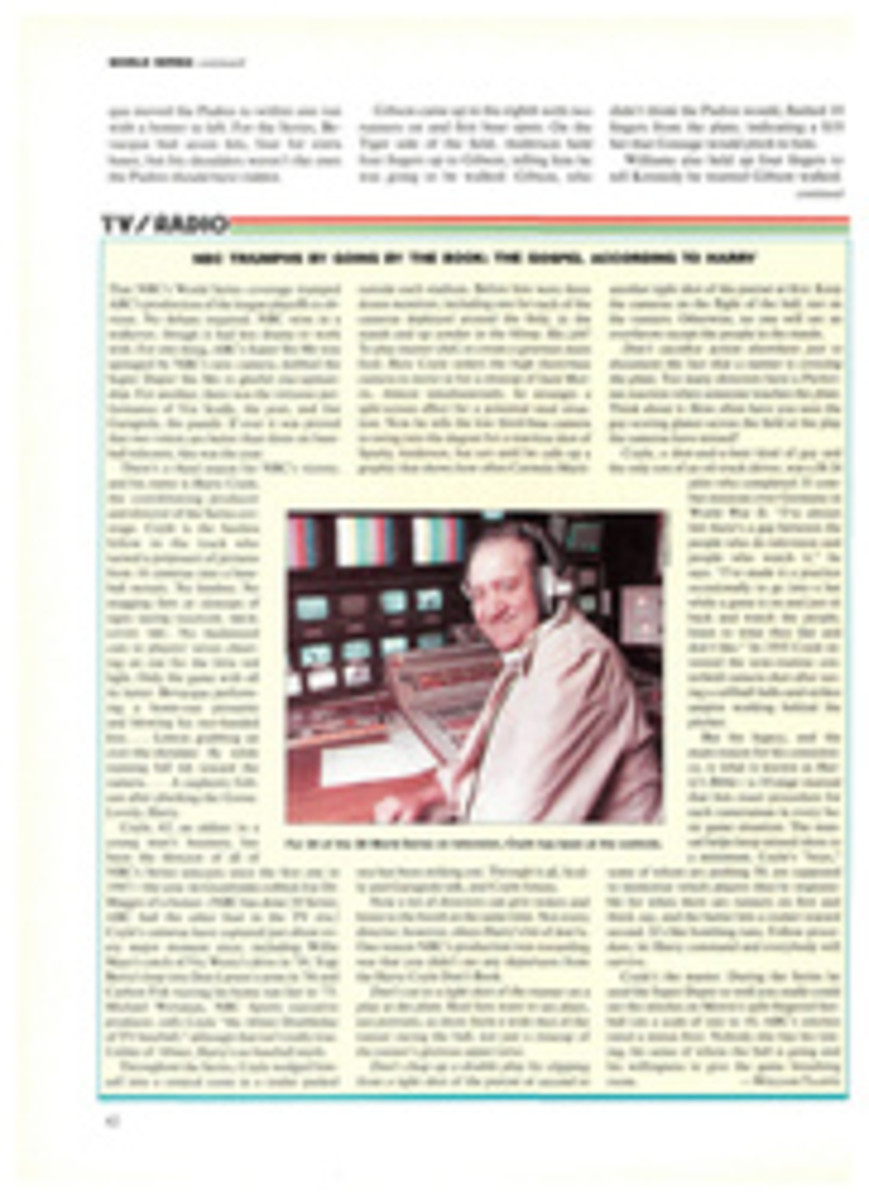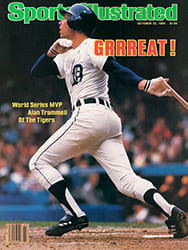
SOME LEFTHANDED THINKING HAS KEPT SOUTHPAWS FROM BEING CATCHERS
Lefthanded catchers are a rare breed. Of the couple of dozen southpaws who have played behind the plate in the big leagues, only one, Jack Clements (1884-1900), had much of a career, and since 1906 only two lefties have caught in major league games—Dale Long in 1958 and Mike Squires in 1980. Despite baseball custom, there is no convincing reason why a lefty can't be an acceptable big league backstop. The advantages a southpaw would enjoy far outweigh any disadvantages, and some are so striking, it's puzzling that the position has remained almost exclusively the domain of righthanders.
The main advantage a lefty catcher has over a righty is in throwing to first base, and the reason is obvious. "A righthanded catcher has to pivot to make a throw to first, but for a lefthander, the plays are all in front of you," says Squires, who caught in the late innings of two games for the White Sox. Three plays are particularly advantageous to the lefthanded thrower. One is fielding bunts: A southpaw doesn't have to circle the ball in order to be in position to throw to first. Second, a lefty can make a much quicker pickoff throw to first base and, equally important, not telegraph the throw with a pivot. (Long picked a runner off first in one of his two brief appearances with the Pirates as a catcher.) Third, there is the double play—with the bases loaded when the ball is hit to the left side of the infield—in which the catcher takes the infielder's throw for the force at home, then fires the ball to first.
What's more, a righthanded pitcher's curve breaks into a lefthanded catcher's mitt, whereas a righthanded catcher frequently has to backhand a sharply breaking slider or curveball.
The only play that puts a southpaw catcher at a disadvantage is trying to throw out a runner stealing third, because a lefty has to pivot to make that throw. Of such a situation, Squires says, "You just get the ball, and you throw down there. It's not that tough."
There are two other common arguments against the use of lefthanded catchers. One is that in throwing to second, a lefty has trouble getting the ball over righthanded batters. "It's been theorized that because of the preponderance of righthanded hitters, it may be more difficult for a lefthanded catcher to throw with a righthanded hitter in the box," says Dean Taylor, assistant director of scouting and player development for the Kansas City Royals.
Long, now a field representative for the National Association of Professional Baseball Leagues (the governing body of minor league baseball), scoffs at that belief. "You hear people say you might hit the batter, but I had no disadvantage with that," says Long. "I'm 6'4", and the hitters didn't bother me." Clements, who caught more than a thousand games in the majors (mostly with the Philadelphia Phillies), apparently encountered few problems. "It was either give plenty of room when he was throwing," Clements's teammate Al Maul once said, "or else have the ball hurled in your face with all his strength."
One reason baseball people frequently give for not allowing southpaws to catch is that lefties have a natural tail to their throws, and in pegging down to second, the ball will tail toward the shortstop side of the bag. "Most lefties have a live arm with a follow-through that's always going away from the play," says Bob Fontaine, director of player personnel and scouting for the San Francisco Giants. It's not clear whether this line of reasoning means that: 1) a lefty can't throw straight, 2) most lefties don't throw straight, or 3) a lefty doesn't have the intelligence to compensate for the "natural" tail in his throw. In any event, the argument just doesn't hold water. "My ball was too straight—that's why I couldn't pitch," says Jeff Pentland, who caught lefthanded for the Lodi Padres of the Class A California League in 1971. "It's all grip pressure. If you get good rotation on the ball, it stays straight. I had no problem keeping it straight." Squires agrees: "If you develop a good overhand throw, the ball's not going to tail whether you're lefthanded or righthanded."
So, if, as the evidence indicates, lefties are capable of being catchers, why have they been kept from the job? It seems to come down to a blind adherence to tradition, and in baseball, as we know, tradition dies hard. A youngster who throws left will rarely be given a chance to catch (try to find a lefthanded catcher's mitt in a sporting-goods store), and even if he is, by the time he reaches college or the minor leagues, he'll have been converted to another position. Babe Ruth and Lou Gehrig, it may be noted, both played catcher when they were kids. In baseball it's simply axiomatic that lefties don't catch. Bernie DeViveiros, 83, who spent 25 years as a scout and instructor with the Detroit Tigers, and is perhaps as knowledgeable as anyone about the game, expresses the traditional view: "I don't think there'll ever be lefthanded catchers. If I was a manager, I wouldn't want one. I'd go along with a righthander. That's the way it's been."
Appropriately enough, Branch Rickey and Bill Veeck, two of baseball's greatest innovators, were the ones responsible for giving Long and Squires, respectively, the opportunity to play catcher.
Long's invitation to catch came at the Pirates' spring training camp in 1951. Typically, Rickey's reasons for this unorthodox move seem to have been fairly complex. For one thing, it was good p.r., and The Mahatma, who died in 1965, was never adverse to getting ink. The March 14 and 21 editions of The Sporting News carried stories about the experiment. (With the second story was a photo of Long in a catcher's crouch, holding a baseball in his left hand and wearing, as he had once in a high school game, a catcher's mitt made for a righthander on his right hand.) In these articles Rickey, himself a former major league catcher, explained his motives.
He pointed out the advantage a lefthanded catcher has in throwing to first base. Rickey continued, "The only objection I can see is that it would be against custom. But why shouldn't we try it? But my main reason for trying this was that I'm thinking in terms of the future." Rickey's projection was based on Long's stats at Binghamton the previous season: 27 home runs and an Eastern League-record 130 RBIs. Because the Pirates had drafted Long from the Yankees' Kansas City farm club during the off-season, Rickey had to keep the lefthanded slugger on Pittsburgh's major league roster for the '51 campaign, or risk losing him to the Yankees. However, Long appeared in only 10 games for the Pirates that year and never as a catcher; in midseason he went to the St. Louis Browns and spent the next three seasons in the minors.
However, on Aug. 20, 1958 when Long was with the Cubs, catcher Sammy Taylor was lifted for a pinch hitter late in the game. With one out in the ninth, Taylor's replacement, Cal Neeman, got into a heated argument with umpire Frank Dascoli, and was ejected. Cubs manager Bob Scheffing appealed to Dascoli, pointing out to no avail that he had no more catchers. Long, who had been playing first base, was asked to catch. He caught the final two outs with his first baseman's mitt. He appeared behind the plate once more that season.
Squires got his chance as a result of a spring training conversation with White Sox general manager Roland Hemond. "We were talking about lefthanded-hitting catchers," recalls Squires (who, by the way, played 13 games in '84 at third base, another position customarily reserved for righties). "I mentioned that I'd always wanted to be a catcher, and he thought [Sox president] Bill Veeck would like that idea. I told him I wouldn't do it if they were going to make a joke out of it, and he assured me they wouldn't. So we called the glove company, and the next day they had a lefthanded catcher's mitt there."
"Except for second base, I think a lefthander could play any position," says the lefthanded Veeck. "I thought Mike Squires could catch—he's a good enough athlete to play anywhere. There's no reason I know of why a lefthander shouldn't catch just as adequately as a righthander. I don't think the preference for righthanded catchers has any factual basis except for tradition. It's just an ingrained prejudice that starts pre-Little League with the tyranny of an 80 percent righthanded majority! Why should they give up a position to a lefthander?"
Indeed, perhaps the most curious aspect of the ban on lefthanded receivers is that most baseball men, when pressed, will acknowledge that, aside from tradition, there's no convincing reason why a southpaw couldn't catch. "Most young lefties are discouraged early in their careers, so they never find out whether they can catch," says Fontaine, "but if somebody had the tools and a true arm, why not? I don't think we're against anyone who can play."
Catching is a difficult position to learn, so the sooner a player starts catching, the better. "I wish they started me out earlier," says Pentland, now an assistant baseball coach at Arizona State, "because my mechanics were not what they should have been. I was catching guys like Mike Caldwell and Dan Spillner with a store-bought mitt because the custom mitt we ordered took a long time to come. These guys had major league arms, but they were all over the map in those days. The only catching I'd done was in the bullpen and during BP, and if any balls were in the dirt, I'd just jump out of the way. Well, when I first started catching in games, if there was nobody on, I'd jump out of the way of a pitch in the dirt, and the ball would hit the umpire. The umpires kept telling me, 'Hey, I've got kids and a wife!' It took me a while to get used to hanging in there consistently."
Says White Sox manager Tony LaRussa, the man who gave Squires his assignments behind the plate, "You don't ever see a young lefthander given a catcher's mitt. But if you had the perfect guy, and he was brought along as a lefthanded throwing catcher, and he was capable of playing in the big leagues, I think it could be done."
Any young Ruths or Gehrigs out there listening?
ILLUSTRATION
STUART GOLDENBERG

